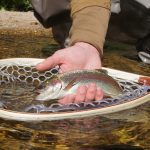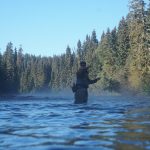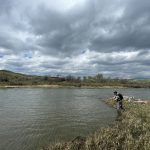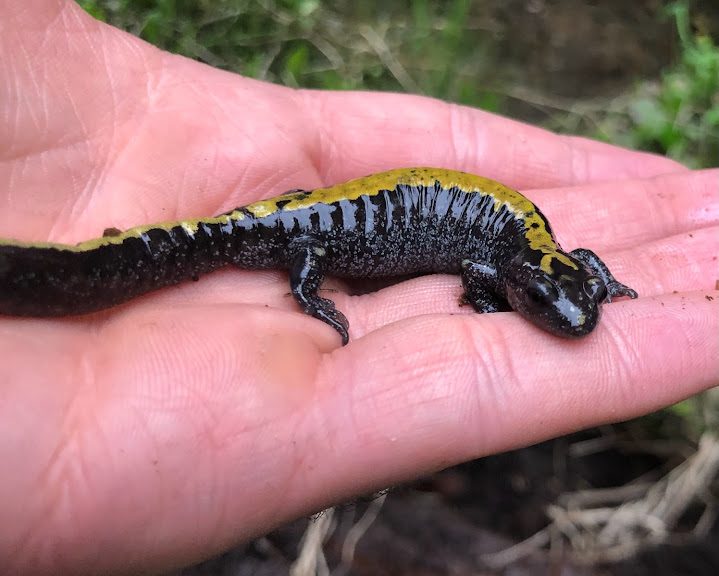
Sallys and Trout: An Ecological Conundrum
Typically when anglers hear the word ‘Sally,’ they think about a big, juicy, yellow stonefly- known as the Yellow Sally. However, in this post, I am going to talk about another type of trout food – the Long-toed Salamander, or what I have come to know as ‘Sallys’.
Much of what I am going to be discussing in this post is based on research done by my friend, Kaegan, who last summer was conducting field research on Long-Toed Salamander for his masters, developing a baseline population distribution for Alberta. Much of what I will say is based on long discussions with him, as well as my own observations from many hours spent conducting field work in Southern Alberta. I was continually on the lookout for Salamanders all last summer, both out of personal interest and because I knew any data I could provide would also benefit Keagan’s research. In this post, I will discuss fish stocking, ecological integrity, and why salamanders could provide important clues for wildlife managers.
Long-Toed Salamanders
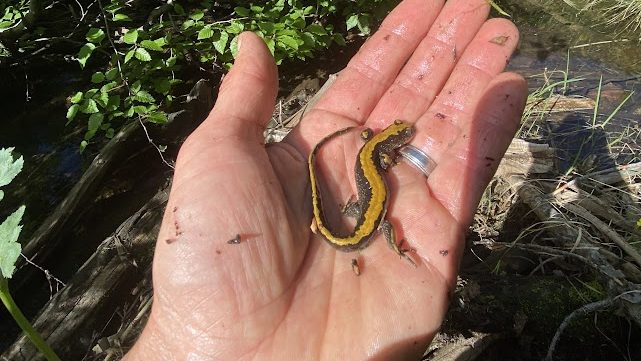
The Long-Toed Salamander is probably the most common salamander species in the Rockies and Foothills of Alberta, and if you’ve seen a salamander, it’s most likely that it was a Long-toed Salamander. They are super cool, and can be found in wet areas, typically in lakes and ponds. They have a yellow stripe down their back, and one really long toe. Interestingly enough, looking at the at the ecology of this amphibian can reveal a lot about the ecological impacts of human intervention- specifically, the impact of fish stocking into places they shouldn’t be.
Fishless Lakes Are Not Lifeless Lakes
Ever since European’s first settled the west, they brought with them an unwavering commitment to altering aquatic ecosystems. The local fish populations were always inferior, and were usually replaced with “proper” sportfish, like rainbow trout and brown trout. Any water body, particularly lakes, were seen as a wasted opportunity if they were fishless; subsequently, most lakes that were not inhabited naturally by trout were hastily stocked with trout. Sometime these species were the native species (ie. Westslope Cutthroat Trout), while in other cases, they were introduced (ie. Dolly Varden, Rainbow Trout, Brook Trout, and Golden Trout). What was not considered in any way, shape, or form during this wave of fish stocking that took place throughout the 20th century (and still continues today) was how introducing trout would affect the plant and animal communities already present in those lakes. Sallys provide a great example of what can result.
You see, humans are very egotistical. Usually, the only wildlife we care about are the wildlife that benefit us. We tend not to place much value on animals that are small, inconspicuous, or not commercially important as a food or recreational resource. The perfect example of this is the Long-Toed Salamander, which are found in fishless lakes, ponds, and streams throughout the foothills of Alberta.
In this post, I am using Salamanders as an example. But they are only the poster child. What I am trying to convey is just how disruptive trout can be when introduced into lake systems that have historically been devoid of trout. Trout are aggressive carnivores that predate on basically anything small enough for them to eat. Introducing them to lakes drastically lowers the amount of aquatic invertebrates, amphibians, and other animals that predate on those species. The biomass goes into the trout. The biodiversity goes down.
Long-toed Salamanders and trout cannot coexist. Salamanders are almost never found in lakes that have trout . This is likely because they use the same habitats for spawning, and salamander eggs are quicky eaten by trout when they are laid. Trout also drastically lower the food available for adult salamanders. In systems where trout are not present, there are typically salamanders- they occupy the top of the food web, acting as the primary predators of aquatic invertebrates. The exception to this rule appears to be with golden trout, which seem to coexist well with salamanders (probabaly because they only eat insects sz. 22 and smaller!).
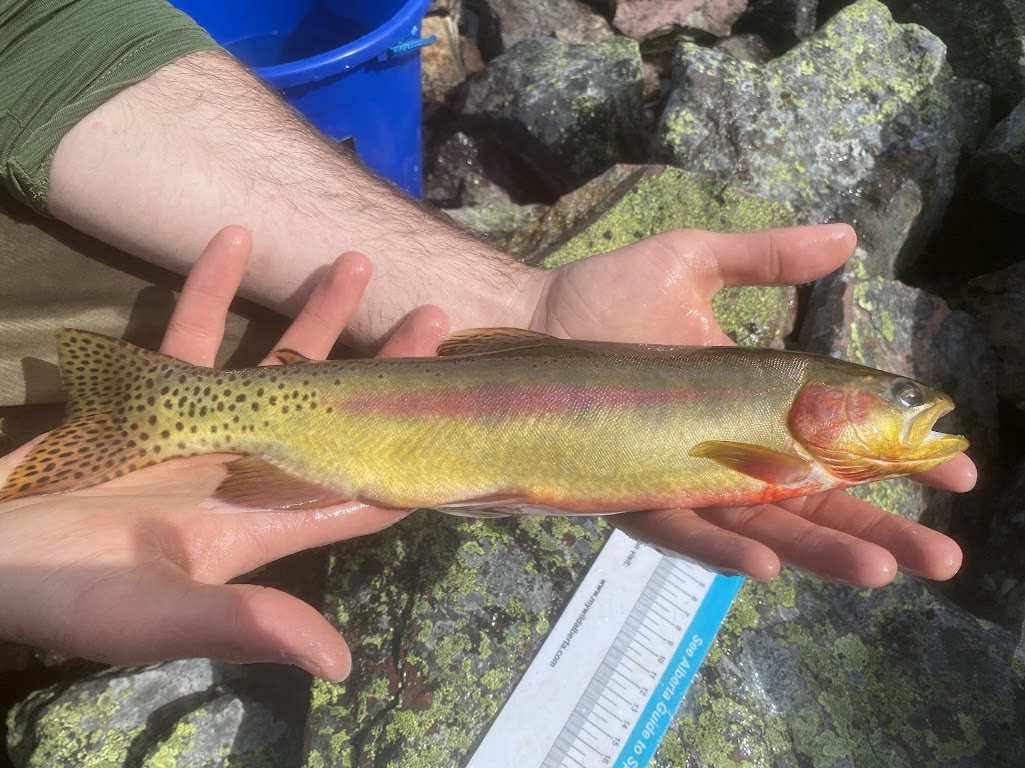
Fish migration and migratory barriers are important in understanding ecology and species composition. The long and short of it is that there are many lakes in the west that were colonized naturally by trout (no migratory barriers/waterfalls), along with many that were never colonized (barriers prevented fish migration). Those that were not colonized by fish often have far richer species diversity and harbor a vast number of invertebrates and microorganisms compared to those that were not colonized. They also play host to amphibians such as Long-Toed salamanders.
However, what we did is aggressively stock fish into all these unique ecosystems, essentially eliminating this biodiversity. When looking at the distribution of Long-Toed Salamanders across the west, there are a few obvious breaks in the distribution- one of these areas is the Highwood pass, an area where almost all lakes were subject to fish stocking activities. Could it be that the absence of Salmanders in this area is due to this fish stocking? I think it’s very likely, and a good example of why we need to be much more conscious of where we go putting fish.
First Hand Evidence
This past summer, I was lucky enough to see all of this first hand. I worked on a project sampling a variety of alpine lakes in Southern Alberta. We helicoptered to over a dozen lakes as part of this project. As a promise to my friend, myself and the rest of the crew were on the lookout for salamanders and their eggs. In lakes with Golden Trout, the fish and the Salamanders coexisted. In any lakes that had any other type of fish, we saw no signs of salamanders or their eggs. In all lakes that were devoid of fish, we found an abundance of Salamanders.
A great example of this was the contrast between South Scarpe Lake and West Scarpe Lake. These two lakes are only a few kilometers away from one another; South Scarpe contains Rainbow Trout while West Scarpe is fishless. South Scarpe was loaded with Rainbows, however as we sampled the shoreline habitat and the tributary, we saw no signs of salamanders anywhere. Then we flew a few KM over to West Scarpe, and the difference couldn’t have been more obvious. Even just looking at the water with the naked eye it was abundantly clear that their was much more life- we saw several types of leeches and worms, small crustaceans, far more insect life, and salamander eggs were present along the entire shoreline. Even these crude observations made it obvious that the species composition was far different between the two lakes, and that many of these species would not survive in the presence of fish.
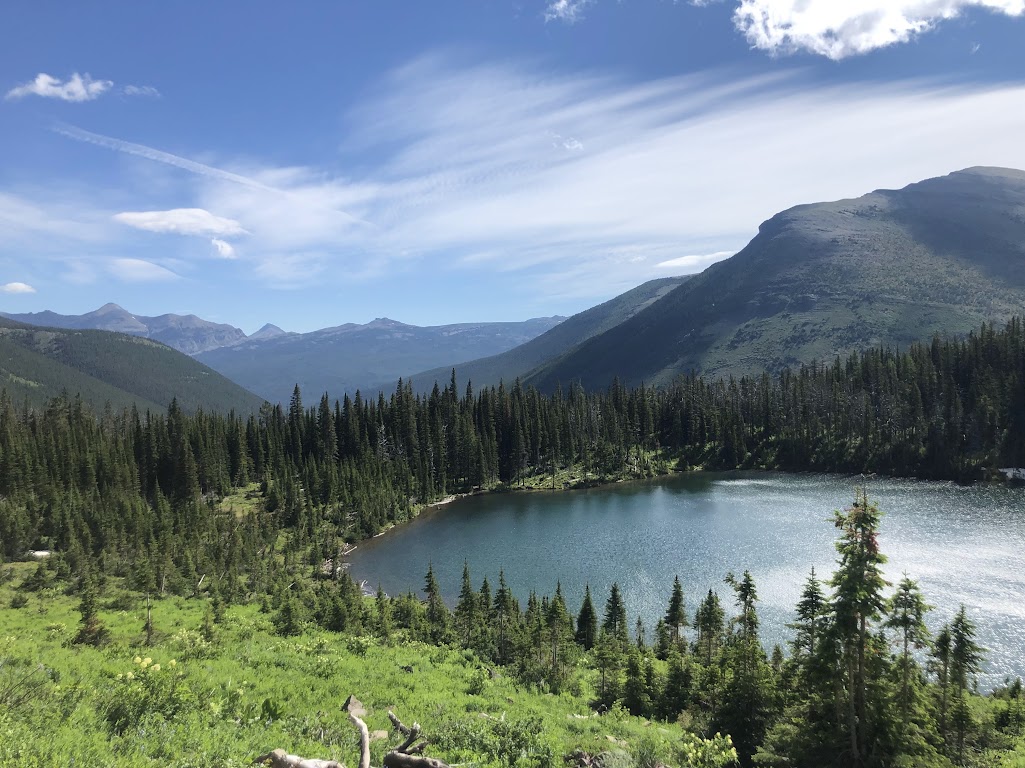
That brings us to the whole point of the article: Should we be stocking fish into these environments? And taking it one step further: Should we be forcefully removing them from places they shouldn’t be?
This is a topic that I have seen spark debate online and on forums. Unfortunately, there seems to be a heavy bias from anglers when it comes to how we feel these ecosystems should be managed. There has been some controversial fish removals in Banff National Park, instances where Brook Trout and Yellowstone Cutthroat Trout were removed from lakes using rotenone. In some cases, like Katherine Lake, no fish re-introductions are planned. Many anglers were outraged… However, Katherine Lakes was historically devoid of fish, and removing fish gives the possibility of recolonization by species such as Long-toed Salamanders. Let us not forget, ‘Ecological Integrity’ is part of Parks Canada’s mandate; should that mandate be forgotten because anglers believe it’s their right to fish wherever it’s possible?
This is just one perspective- I’m not even saying I agree or disagree. These issues get convoluted quickly, and there are many factors at play. But I think it’s important for anglers to take a step back and remember that the ecosystem is a lot larger than just trout, and to remember that sometimes natural resources should be managed for more than just recreational or commercial purposes.
If anything, this post reflects my general perspective that fish stocking often does more harm then good. Fish stocking should focus on places where fish were historically present (ie. connected to source populations) and only native species should be introduced using local brood stocks. I agree with some stocking to maintain catch-and keep fisheries in places where angling is too heavy, and also stocking lakes to provide accessible fishing opportunities (ie. stocked ponds). Sometimes, when managing fisheries, less is more. Fish don’t have to be everywhere- ecosystems still have value even when there is nothing but a bunch of worms, leeches, bugs, and crayfish, along with some cute little Sallys who love to eat them. If we anglers are to be the ecosystems greatest protectors, we have to protect all species, not just the ones that benefit us.
Salamanders are super cool; and they are the perfect poster boy for what ecological integrity can look like, and how often times that integrity is lost when fish are introduced. For me, trout are often this beacon of ecological integrity- a species that needs pristine environments to thrive. However, the more I expose myself to more ecosystems, the more I begin to realize that often times trout are an indicator of a broken system- they often thrive in environments that should be occupied by something else. Salamanders are that something else, and a species that we should all care about, even if its just as a little reminder that wildlife is cool, and all of it should be cherished.
Please let me know your thoughts- should we be stocking fishless lakes? Have you ever seen a Salamander? Are we OK giving up angling opportunities to maintain ecological integrity? Leave your comments below or email me if you have questions, or if you would like to contact Keagan about his research.
I hope you enjoyed the post and it sparked a little reflection. Next time you are on the water, keep your eyes peeled for Sallys- it means your probably fishing the wrong lake!

